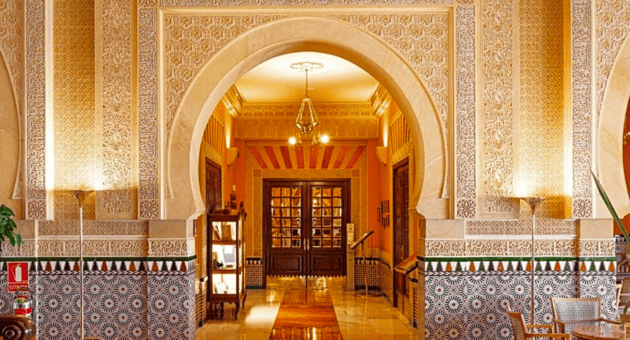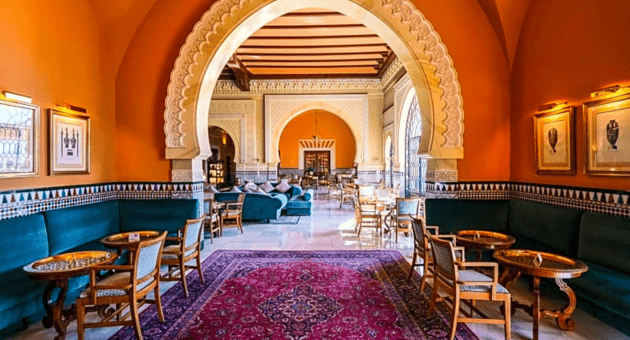When it comes to historical and architectural marvels, the Alhambra Palace in Granada, Spain is a must-visit. This sprawling palace, made up of several buildings and gardens, is a true testament to the rich history and culture of the country. Let’s take a closer look at the fascinating history, awe-inspiring architecture, and captivating art of the Alhambra Palace.
A Brief History of the Alhambra Palace

The Origins of the Alhambra
The Alhambra’s origins date back to the 9th century when it was initially constructed as a fortress by the Moors who ruled the Iberian Peninsula at the time. It was built on a strategic location on a hill overlooking the city of Granada, providing an excellent vantage point for defence. The fortress was known as “Qalat Al-Hamra,” which means “the red fortress” in Arabic, due to the reddish hue of the walls. The original fortress consisted of a watchtower, barracks, and a cistern, all of which were made of adobe and wood.
The fortress underwent several phases of expansion and refinement, with some of the original structures being replaced by more imposing ones. In the 11th century, the fortress was expanded by the Zirid dynasty, who added a wall and towers to protect the citadel. The Almoravid dynasty further expanded the fortress in the 12th century, adding a mosque, a palace, and a residential area for the ruling elite.
The Nasrid Dynasty and the Golden Age
In the 13th century, the Nasrid Dynasty took control of Granada and transformed the fortress into a palace that served as the residence of the sultan and his court. This period is known as Alhambra’s Golden Age, where the palace’s architecture, art, and culture reached its height. The Nasrid kings commissioned several additions and decorations, including the famous Alhambra tiles, intricate stucco work, and fountains.
The most significant addition during this period was the Palace of the Lions, built by Muhammad V in the 14th century. The palace is known for its exquisite decoration and its central courtyard, which features a fountain supported by twelve marble lions. The palace also has a hall of justice, a throne room, and several private chambers for the sultan and his family.
The Reconquista and the Christian Influence
The 15th century saw the end of Muslim rule in Spain when the Catholic monarchs Isabel and Ferdinand reconquered Granada from the Moors. They made the Alhambra Palace their royal court and commissioned their own additions to the palace, such as the Palace of Charles V, a Renaissance-style building. The Catholic influence in the palace is also evident in the art and decoration, with Christian symbols and motifs being added to the original Islamic ones.
The Palace of Charles V was built in the 16th century by the Holy Roman Emperor Charles V, who wanted to establish a permanent residence in Granada. The palace is a square building with a circular courtyard, and it combines Renaissance and Mannerist styles. The palace was never completed, and it was used for various purposes throughout the centuries, including as a barracks and a prison.
Modern-Day Preservation and Restoration Efforts
The Alhambra Palace has undergone several restoration and preservation efforts throughout the years, with the most significant one taking place in the 20th century after a devastating earthquake damaged some of the structures. The restoration work included the reconstruction of collapsed walls, the reinforcement of foundations, and the repair of decorative elements. Today, the palace is designated as a UNESCO World Heritage Site and is one of the most visited tourist attractions in Spain.
The Alhambra Palace is not only a testament to the rich history and culture of Andalusia but also a symbol of the coexistence of different religions and civilizations. The palace’s architecture, decoration, and art reflect the influences of Islamic, Christian, and Renaissance cultures, making it a unique and fascinating destination for visitors from around the world.
Architectural Marvels of the Alhambra

The Nasrid Palaces
The Nasrid Palaces are the highlight of the Alhambra Palace, and it’s easy to see why. This series of interlocking buildings is a stunning example of Islamic architecture, with intricate tile work, stucco decoration, and geometric designs adorning every surface. The highlight of the Nasrid Palaces is without a doubt the Court of the Lions, a majestic courtyard with a fountain in the centre.
The Alcazaba Fortress
The Alcazaba Fortress is a testament to the Alhambra’s origins as a fortress. This massive complex of walls, towers, and gates was designed to protect the palace and its residents from external threats. Visitors can climb to the top of one of the towers for a panoramic view of Granada and the surrounding landscape.
The Generalife Gardens
The Generalife Gardens are an oasis of calm and tranquillity within the bustling palace complex. These beautifully manicured gardens are filled with fountains, streams, and lush vegetation and were designed to be a place of relaxation for the Nasrid kings. The gardens offer breathtaking views of the Alhambra and the city below.
The Palace of Charles V
The Palace of Charles V is a unique addition to the Alhambra Palace. This massive Renaissance-style palace was commissioned by the Catholic king in the 16th century and was designed to be his royal residence. Today, the palace houses two museums, with one dedicated to the history of the Alhambra and the other to fine arts.
The Art and Symbolism of the Alhambra

Intricate Tilework and Stuccowork
One of the most striking features of the Alhambra Palace is its intricate tilework and stuccowork. These elaborate decorations adorn every surface of the palace, from the walls to the ceilings, and feature a unique blend of Islamic and Christian motifs. The tile work is so intricate that it’s almost impossible to find two identical pieces in the entire palace.
The Importance of Water Features
Water is a recurring theme in the art and architecture of the Alhambra Palace. Fountains, streams, and pools can be found throughout the palace, with water flowing both indoors and outdoors. The importance of water in Islamic art stems from the religion’s reverence for the element. Water is seen as a symbol of life, purity, and abundance and is used to create an ambience of refreshment and contemplation within the palace.
Calligraphy and Inscriptions
Calligraphy and inscriptions are an important part of Islamic art, and the Alhambra Palace is no exception. The walls of the Nasrid Palaces are adorned with intricate calligraphy, with verses from the Quran and other Islamic texts being used as decorative elements. The calligraphy is so beautifully crafted that it is often seen as an art form in and of itself.
The Influence of Islamic Art and Culture
The Alhambra Palace is a prime example of the rich history and culture of Islamic Spain. The palace’s architecture, art, and decoration are a testament to the ingenuity and creativity of the people who built it, and the influence of Islamic culture can still be seen in Spain today. After visiting the Alhambra Palace, it’s easy to see why it’s considered one of the most iconic landmarks in the country.


